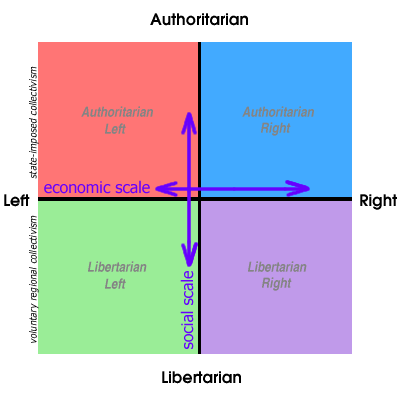Dimensionality matters: three implications of ideology being multidimensional
Left or right? Liberal or conservative? Blue or red? We know the terms bandied about in the punditverse, but it’s easy to forget that there is more than one way to divide the world into two political ideologies.
If you categorize political ideology into two camps, you are implicitly using a one-dimensional model, a model that puts everyone on a single line from left to right.
If you think there are two basic issues — how much the government should influence the economy and how much the government should influence social issues — then you are using a two-dimensional model, a model that locates each person on a plane.
So here’s a question: How many dimensions are there in political ideology? This question is a lot like the question “How long is the coast of Britain?” (alt): the answer depends on how you’re going to use the answer.
If you want to explain variance in the US House and Senate, one dimension is plenty in most cases, and two dimensions is sufficient the rest of the time. If you are looking at an entire (two-year) Congress or a longer period, one dimension will do a good job most of the time
If you are trying to explain a single bill — or each of a set of single bills — the story is more complicated. On a given bill, some legislators vote for ideological reasons, some for procedural reasons, some because of interest groups or constituent pressure, some because of bribes, some because they are taking cues from other legislators, and some just make mistakes. When you are interested in distinguishing among legislators based on aggregate voting, few dimensions are needed. When you want to explain the path a bill takes, more dimensions may be required.
This has implications in three kinds of research we conduct based on the analysis of roll call votes:
- Theorizing about ideology: When building theories about ideology, we cannot blindly assume that ideology is one-dimensional. Arguably there are one-dimensional policy areas, legislators, and specific bills, and the one-dimensional case is worth considering, but it is not anywhere near universal.
- Ideology as an explained variable in empirical work: How do parties, interest groups, constituent pressure, and other factors affect votes? When exploring factors that affect ideology — using statistical models where ideal points on the “left-hand side” — we should not ignore that there may be multiple dimensions to explain.
- Ideology as an explanatory variable: How does ideology affect interactions with the president, the courts, and the bureaucracy? Even scholars of institutions other than Congress should remember that when ideology is on the right-hand side of the statistical model we might want to include more than one dimension.
To indulge in the snowclone, dimensionality matters when considering ideology. Make a mindful choice when modeling it.

Great post, Steve. Your argument is similar to that advanced by Bianco and Sened (2005), and one of the reasons I like their piece so much (and the uncovered set v. acceptable policy range argument). If only I was a little more clear on their grid estimation procedure… 🙂